HI6028 Taxation Theory, Practice & Law: Analyzing Key Tax Concepts
VerifiedAdded on 2020/04/07
|8
|2435
|402
Homework Assignment
AI Summary
This assignment solution for HI6028 Taxation Theory, Practice & Law T2 2017 covers several key areas of taxation. It includes calculating net capital gains and losses from asset sales, determining the taxable value of fringe benefits related to low-interest loans, and analyzing the allocation of rental property losses between co-owners. The assignment also discusses a landmark case concerning tax avoidance schemes and addresses the tax implications of selling timber from a piece of land, referencing relevant tax regulations and legal precedents to support its conclusions. The document is a valuable resource for students studying taxation, offering detailed explanations and practical applications of complex tax concepts, and is available on Desklib, a platform offering a wide array of study tools.
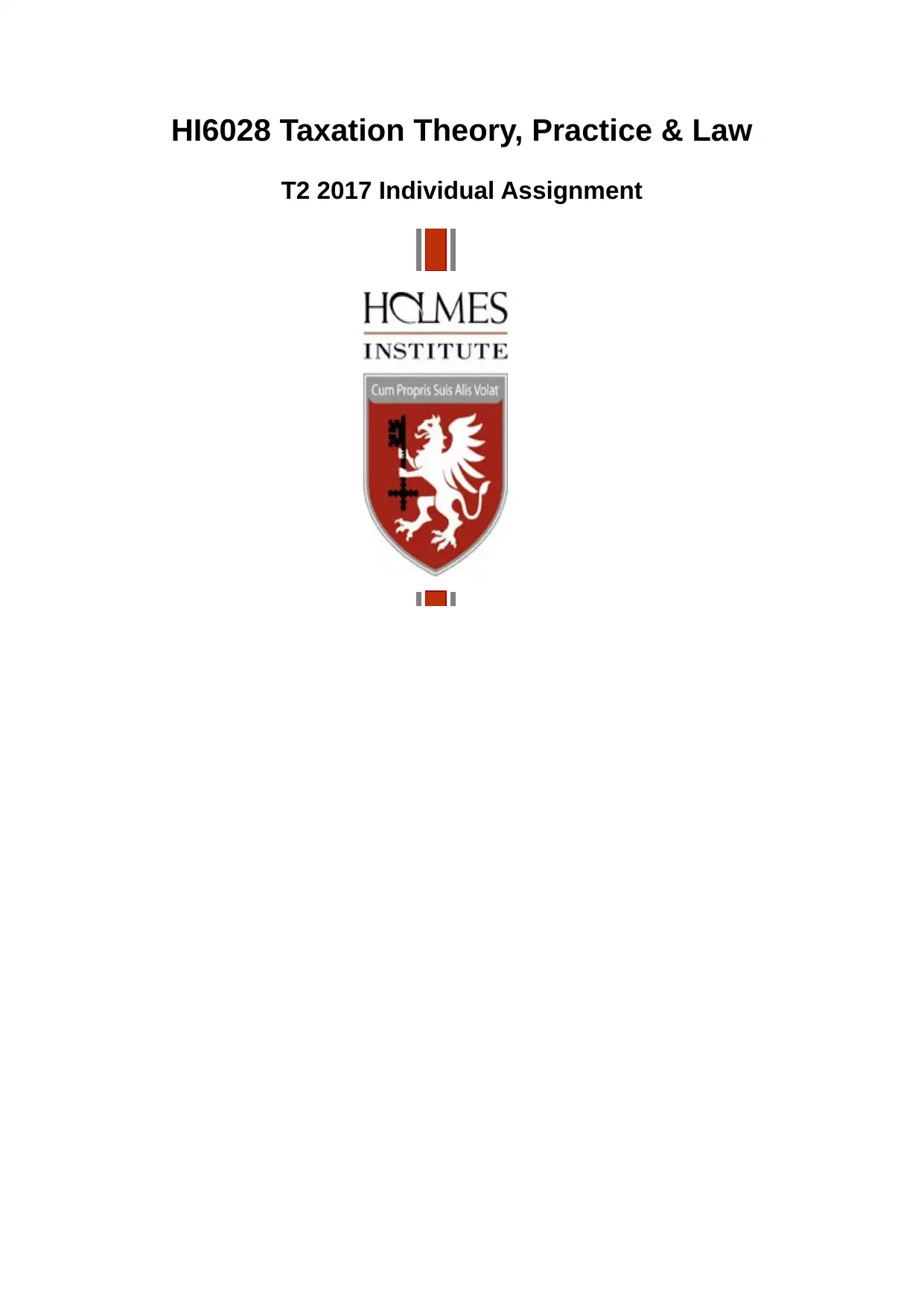
HI6028 Taxation Theory, Practice & Law
T2 2017 Individual Assignment
T2 2017 Individual Assignment
Paraphrase This Document
Need a fresh take? Get an instant paraphrase of this document with our AI Paraphraser

TABLE OF CONTENTS
Question 1..................................................................................................................................3
Question 2..................................................................................................................................3
Question 3..................................................................................................................................3
Question 4..................................................................................................................................4
Question 5..................................................................................................................................4
References..................................................................................................................................5
Question 1..................................................................................................................................3
Question 2..................................................................................................................................3
Question 3..................................................................................................................................3
Question 4..................................................................................................................................4
Question 5..................................................................................................................................4
References..................................................................................................................................5
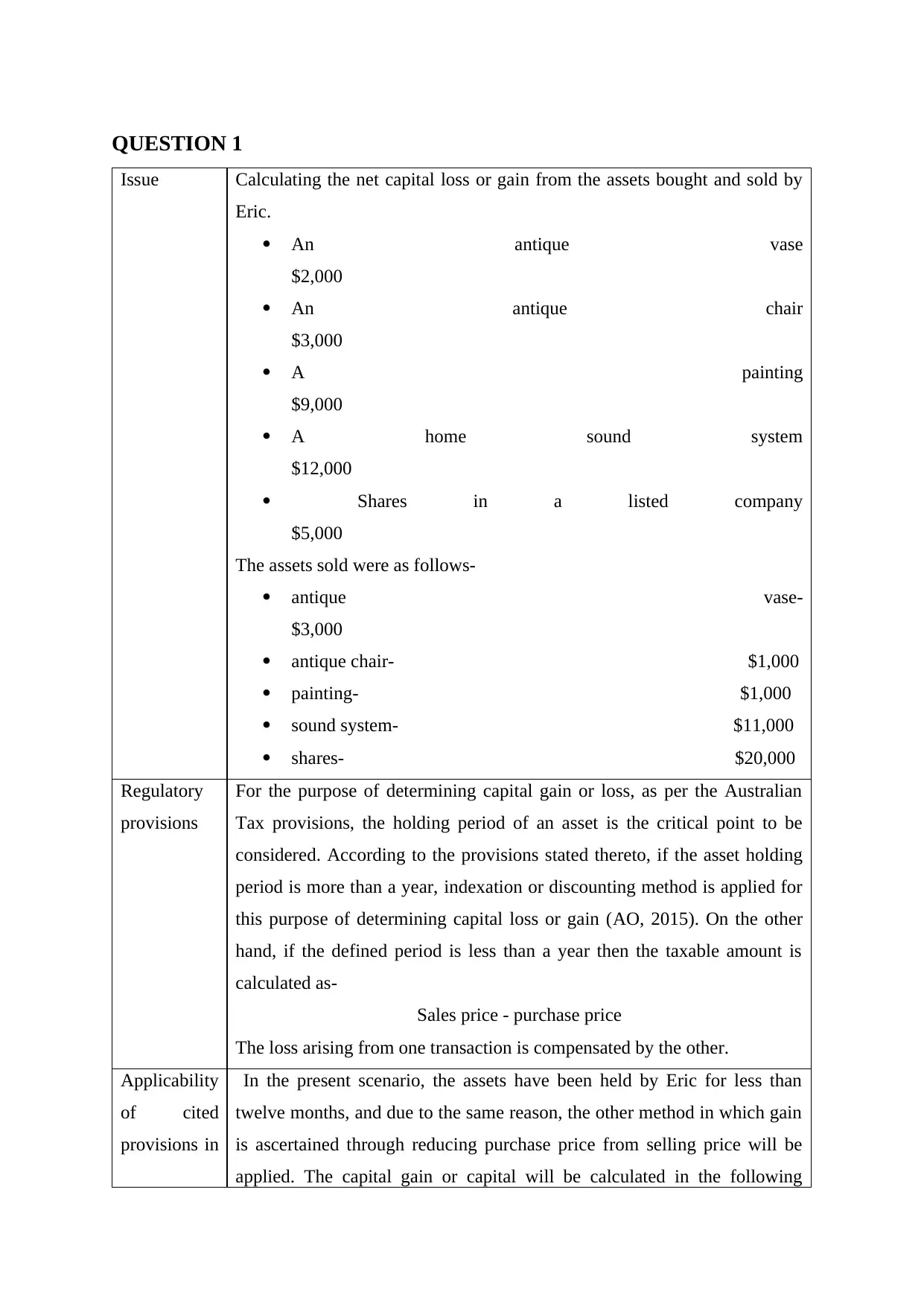
QUESTION 1
Issue Calculating the net capital loss or gain from the assets bought and sold by
Eric.
An antique vase
$2,000
An antique chair
$3,000
A painting
$9,000
A home sound system
$12,000
Shares in a listed company
$5,000
The assets sold were as follows-
antique vase-
$3,000
antique chair- $1,000
painting- $1,000
sound system- $11,000
shares- $20,000
Regulatory
provisions
For the purpose of determining capital gain or loss, as per the Australian
Tax provisions, the holding period of an asset is the critical point to be
considered. According to the provisions stated thereto, if the asset holding
period is more than a year, indexation or discounting method is applied for
this purpose of determining capital loss or gain (AO, 2015). On the other
hand, if the defined period is less than a year then the taxable amount is
calculated as-
Sales price - purchase price
The loss arising from one transaction is compensated by the other.
Applicability
of cited
provisions in
In the present scenario, the assets have been held by Eric for less than
twelve months, and due to the same reason, the other method in which gain
is ascertained through reducing purchase price from selling price will be
applied. The capital gain or capital will be calculated in the following
Issue Calculating the net capital loss or gain from the assets bought and sold by
Eric.
An antique vase
$2,000
An antique chair
$3,000
A painting
$9,000
A home sound system
$12,000
Shares in a listed company
$5,000
The assets sold were as follows-
antique vase-
$3,000
antique chair- $1,000
painting- $1,000
sound system- $11,000
shares- $20,000
Regulatory
provisions
For the purpose of determining capital gain or loss, as per the Australian
Tax provisions, the holding period of an asset is the critical point to be
considered. According to the provisions stated thereto, if the asset holding
period is more than a year, indexation or discounting method is applied for
this purpose of determining capital loss or gain (AO, 2015). On the other
hand, if the defined period is less than a year then the taxable amount is
calculated as-
Sales price - purchase price
The loss arising from one transaction is compensated by the other.
Applicability
of cited
provisions in
In the present scenario, the assets have been held by Eric for less than
twelve months, and due to the same reason, the other method in which gain
is ascertained through reducing purchase price from selling price will be
applied. The capital gain or capital will be calculated in the following
⊘ This is a preview!⊘
Do you want full access?
Subscribe today to unlock all pages.

Trusted by 1+ million students worldwide
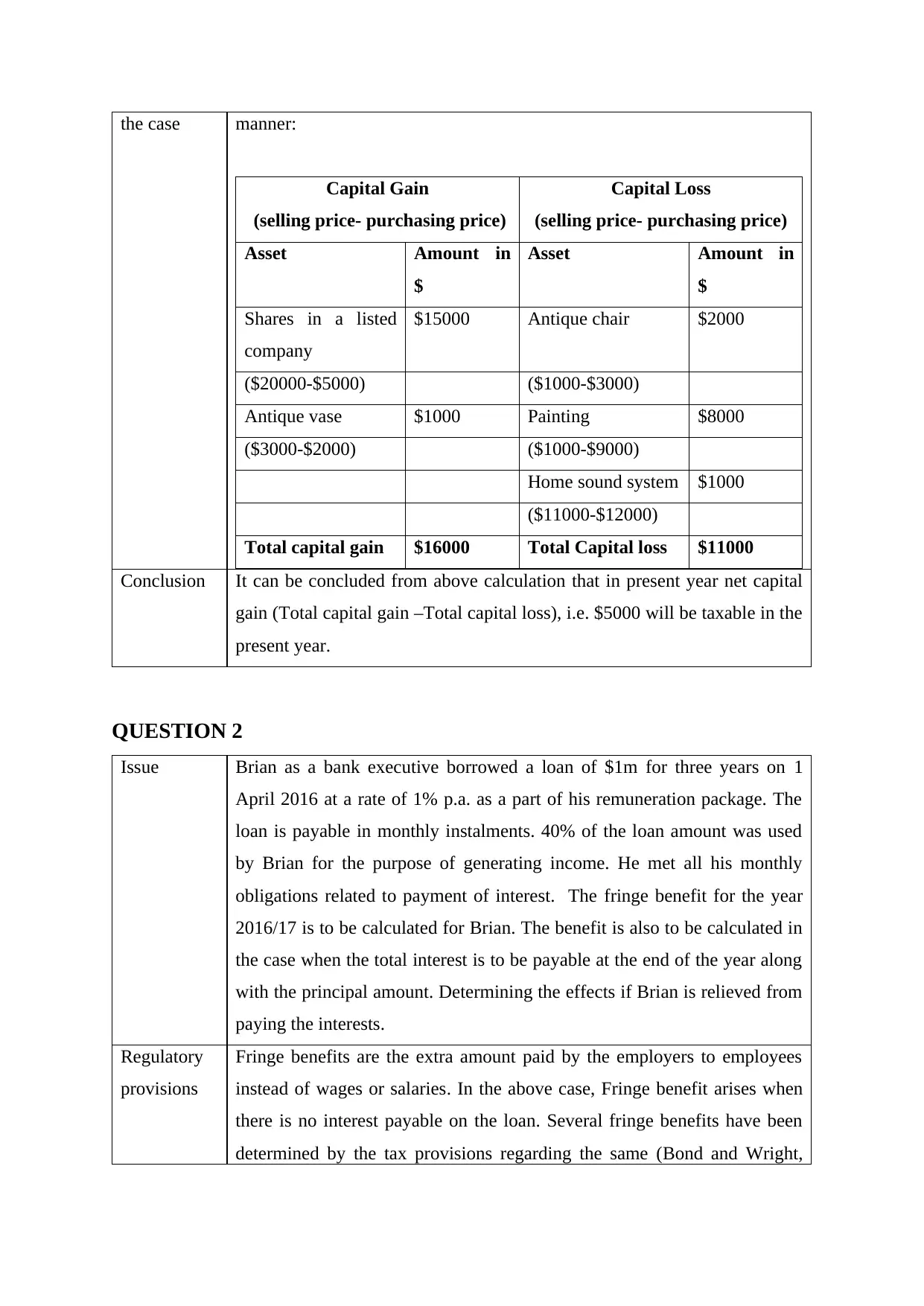
the case manner:
Capital Gain
(selling price- purchasing price)
Capital Loss
(selling price- purchasing price)
Asset Amount in
$
Asset Amount in
$
Shares in a listed
company
$15000 Antique chair $2000
($20000-$5000) ($1000-$3000)
Antique vase $1000 Painting $8000
($3000-$2000) ($1000-$9000)
Home sound system $1000
($11000-$12000)
Total capital gain $16000 Total Capital loss $11000
Conclusion It can be concluded from above calculation that in present year net capital
gain (Total capital gain –Total capital loss), i.e. $5000 will be taxable in the
present year.
QUESTION 2
Issue Brian as a bank executive borrowed a loan of $1m for three years on 1
April 2016 at a rate of 1% p.a. as a part of his remuneration package. The
loan is payable in monthly instalments. 40% of the loan amount was used
by Brian for the purpose of generating income. He met all his monthly
obligations related to payment of interest. The fringe benefit for the year
2016/17 is to be calculated for Brian. The benefit is also to be calculated in
the case when the total interest is to be payable at the end of the year along
with the principal amount. Determining the effects if Brian is relieved from
paying the interests.
Regulatory
provisions
Fringe benefits are the extra amount paid by the employers to employees
instead of wages or salaries. In the above case, Fringe benefit arises when
there is no interest payable on the loan. Several fringe benefits have been
determined by the tax provisions regarding the same (Bond and Wright,
Capital Gain
(selling price- purchasing price)
Capital Loss
(selling price- purchasing price)
Asset Amount in
$
Asset Amount in
$
Shares in a listed
company
$15000 Antique chair $2000
($20000-$5000) ($1000-$3000)
Antique vase $1000 Painting $8000
($3000-$2000) ($1000-$9000)
Home sound system $1000
($11000-$12000)
Total capital gain $16000 Total Capital loss $11000
Conclusion It can be concluded from above calculation that in present year net capital
gain (Total capital gain –Total capital loss), i.e. $5000 will be taxable in the
present year.
QUESTION 2
Issue Brian as a bank executive borrowed a loan of $1m for three years on 1
April 2016 at a rate of 1% p.a. as a part of his remuneration package. The
loan is payable in monthly instalments. 40% of the loan amount was used
by Brian for the purpose of generating income. He met all his monthly
obligations related to payment of interest. The fringe benefit for the year
2016/17 is to be calculated for Brian. The benefit is also to be calculated in
the case when the total interest is to be payable at the end of the year along
with the principal amount. Determining the effects if Brian is relieved from
paying the interests.
Regulatory
provisions
Fringe benefits are the extra amount paid by the employers to employees
instead of wages or salaries. In the above case, Fringe benefit arises when
there is no interest payable on the loan. Several fringe benefits have been
determined by the tax provisions regarding the same (Bond and Wright,
Paraphrase This Document
Need a fresh take? Get an instant paraphrase of this document with our AI Paraphraser
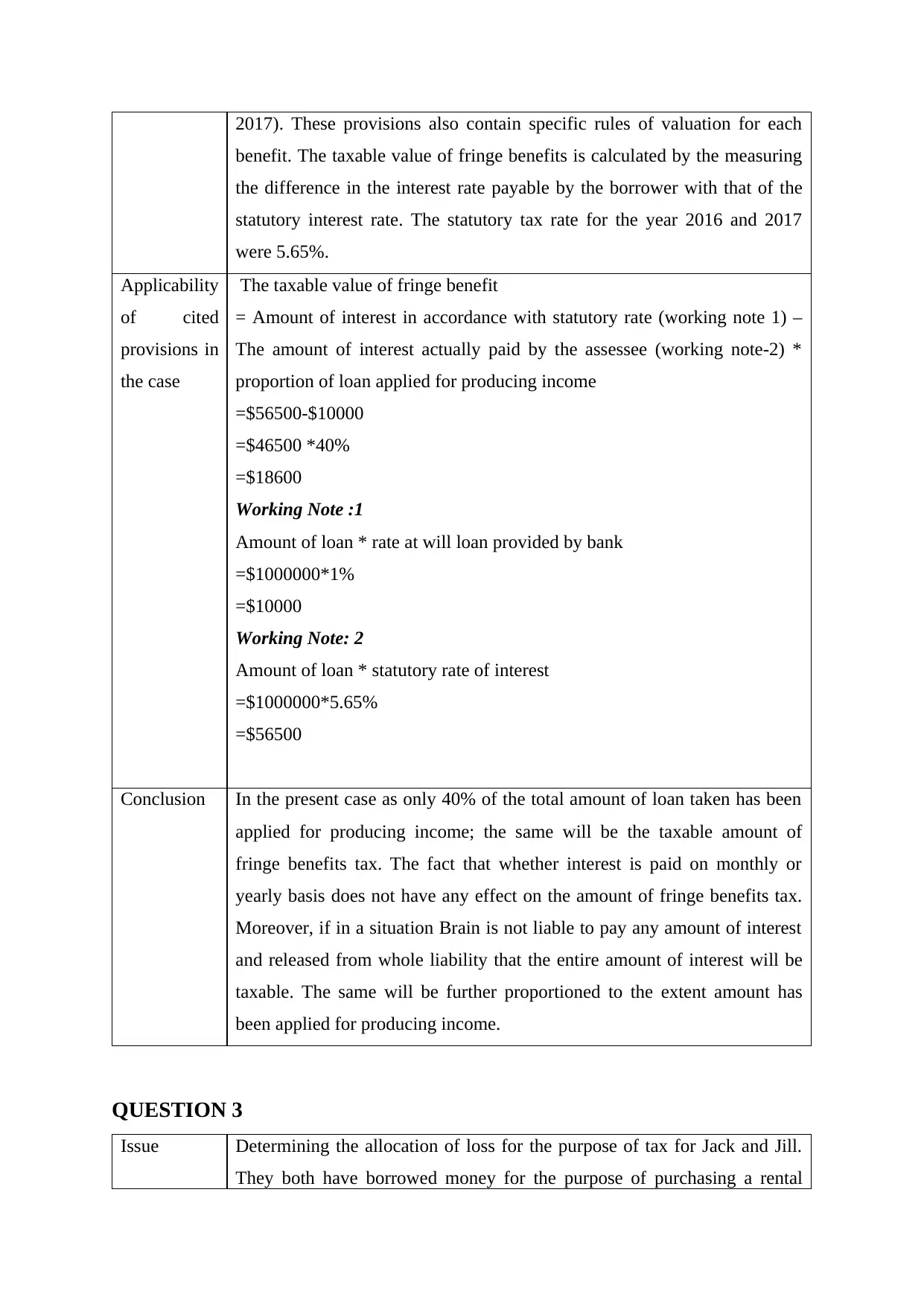
2017). These provisions also contain specific rules of valuation for each
benefit. The taxable value of fringe benefits is calculated by the measuring
the difference in the interest rate payable by the borrower with that of the
statutory interest rate. The statutory tax rate for the year 2016 and 2017
were 5.65%.
Applicability
of cited
provisions in
the case
The taxable value of fringe benefit
= Amount of interest in accordance with statutory rate (working note 1) –
The amount of interest actually paid by the assessee (working note-2) *
proportion of loan applied for producing income
=$56500-$10000
=$46500 *40%
=$18600
Working Note :1
Amount of loan * rate at will loan provided by bank
=$1000000*1%
=$10000
Working Note: 2
Amount of loan * statutory rate of interest
=$1000000*5.65%
=$56500
Conclusion In the present case as only 40% of the total amount of loan taken has been
applied for producing income; the same will be the taxable amount of
fringe benefits tax. The fact that whether interest is paid on monthly or
yearly basis does not have any effect on the amount of fringe benefits tax.
Moreover, if in a situation Brain is not liable to pay any amount of interest
and released from whole liability that the entire amount of interest will be
taxable. The same will be further proportioned to the extent amount has
been applied for producing income.
QUESTION 3
Issue Determining the allocation of loss for the purpose of tax for Jack and Jill.
They both have borrowed money for the purpose of purchasing a rental
benefit. The taxable value of fringe benefits is calculated by the measuring
the difference in the interest rate payable by the borrower with that of the
statutory interest rate. The statutory tax rate for the year 2016 and 2017
were 5.65%.
Applicability
of cited
provisions in
the case
The taxable value of fringe benefit
= Amount of interest in accordance with statutory rate (working note 1) –
The amount of interest actually paid by the assessee (working note-2) *
proportion of loan applied for producing income
=$56500-$10000
=$46500 *40%
=$18600
Working Note :1
Amount of loan * rate at will loan provided by bank
=$1000000*1%
=$10000
Working Note: 2
Amount of loan * statutory rate of interest
=$1000000*5.65%
=$56500
Conclusion In the present case as only 40% of the total amount of loan taken has been
applied for producing income; the same will be the taxable amount of
fringe benefits tax. The fact that whether interest is paid on monthly or
yearly basis does not have any effect on the amount of fringe benefits tax.
Moreover, if in a situation Brain is not liable to pay any amount of interest
and released from whole liability that the entire amount of interest will be
taxable. The same will be further proportioned to the extent amount has
been applied for producing income.
QUESTION 3
Issue Determining the allocation of loss for the purpose of tax for Jack and Jill.
They both have borrowed money for the purpose of purchasing a rental
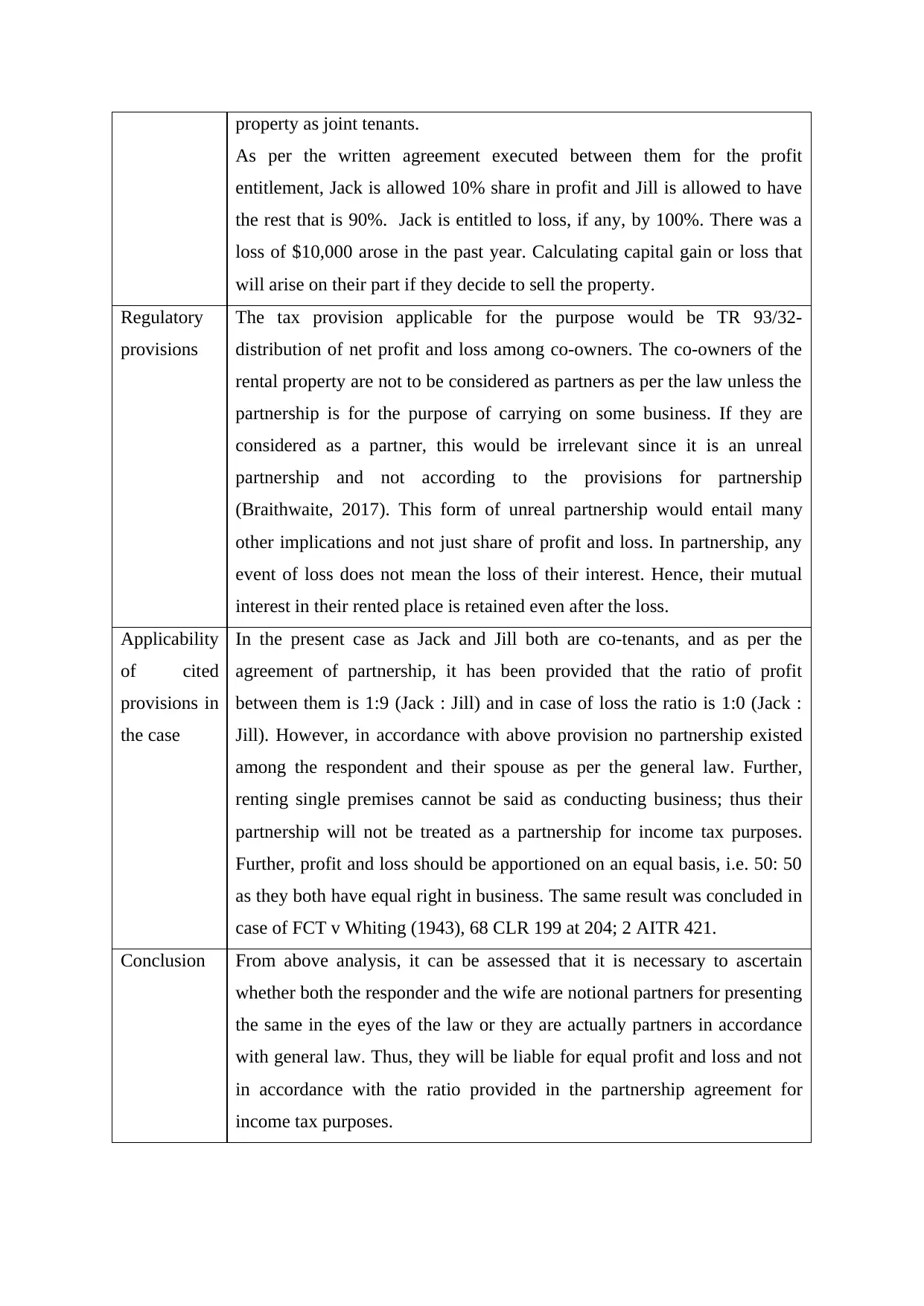
property as joint tenants.
As per the written agreement executed between them for the profit
entitlement, Jack is allowed 10% share in profit and Jill is allowed to have
the rest that is 90%. Jack is entitled to loss, if any, by 100%. There was a
loss of $10,000 arose in the past year. Calculating capital gain or loss that
will arise on their part if they decide to sell the property.
Regulatory
provisions
The tax provision applicable for the purpose would be TR 93/32-
distribution of net profit and loss among co-owners. The co-owners of the
rental property are not to be considered as partners as per the law unless the
partnership is for the purpose of carrying on some business. If they are
considered as a partner, this would be irrelevant since it is an unreal
partnership and not according to the provisions for partnership
(Braithwaite, 2017). This form of unreal partnership would entail many
other implications and not just share of profit and loss. In partnership, any
event of loss does not mean the loss of their interest. Hence, their mutual
interest in their rented place is retained even after the loss.
Applicability
of cited
provisions in
the case
In the present case as Jack and Jill both are co-tenants, and as per the
agreement of partnership, it has been provided that the ratio of profit
between them is 1:9 (Jack : Jill) and in case of loss the ratio is 1:0 (Jack :
Jill). However, in accordance with above provision no partnership existed
among the respondent and their spouse as per the general law. Further,
renting single premises cannot be said as conducting business; thus their
partnership will not be treated as a partnership for income tax purposes.
Further, profit and loss should be apportioned on an equal basis, i.e. 50: 50
as they both have equal right in business. The same result was concluded in
case of FCT v Whiting (1943), 68 CLR 199 at 204; 2 AITR 421.
Conclusion From above analysis, it can be assessed that it is necessary to ascertain
whether both the responder and the wife are notional partners for presenting
the same in the eyes of the law or they are actually partners in accordance
with general law. Thus, they will be liable for equal profit and loss and not
in accordance with the ratio provided in the partnership agreement for
income tax purposes.
As per the written agreement executed between them for the profit
entitlement, Jack is allowed 10% share in profit and Jill is allowed to have
the rest that is 90%. Jack is entitled to loss, if any, by 100%. There was a
loss of $10,000 arose in the past year. Calculating capital gain or loss that
will arise on their part if they decide to sell the property.
Regulatory
provisions
The tax provision applicable for the purpose would be TR 93/32-
distribution of net profit and loss among co-owners. The co-owners of the
rental property are not to be considered as partners as per the law unless the
partnership is for the purpose of carrying on some business. If they are
considered as a partner, this would be irrelevant since it is an unreal
partnership and not according to the provisions for partnership
(Braithwaite, 2017). This form of unreal partnership would entail many
other implications and not just share of profit and loss. In partnership, any
event of loss does not mean the loss of their interest. Hence, their mutual
interest in their rented place is retained even after the loss.
Applicability
of cited
provisions in
the case
In the present case as Jack and Jill both are co-tenants, and as per the
agreement of partnership, it has been provided that the ratio of profit
between them is 1:9 (Jack : Jill) and in case of loss the ratio is 1:0 (Jack :
Jill). However, in accordance with above provision no partnership existed
among the respondent and their spouse as per the general law. Further,
renting single premises cannot be said as conducting business; thus their
partnership will not be treated as a partnership for income tax purposes.
Further, profit and loss should be apportioned on an equal basis, i.e. 50: 50
as they both have equal right in business. The same result was concluded in
case of FCT v Whiting (1943), 68 CLR 199 at 204; 2 AITR 421.
Conclusion From above analysis, it can be assessed that it is necessary to ascertain
whether both the responder and the wife are notional partners for presenting
the same in the eyes of the law or they are actually partners in accordance
with general law. Thus, they will be liable for equal profit and loss and not
in accordance with the ratio provided in the partnership agreement for
income tax purposes.
⊘ This is a preview!⊘
Do you want full access?
Subscribe today to unlock all pages.

Trusted by 1+ million students worldwide
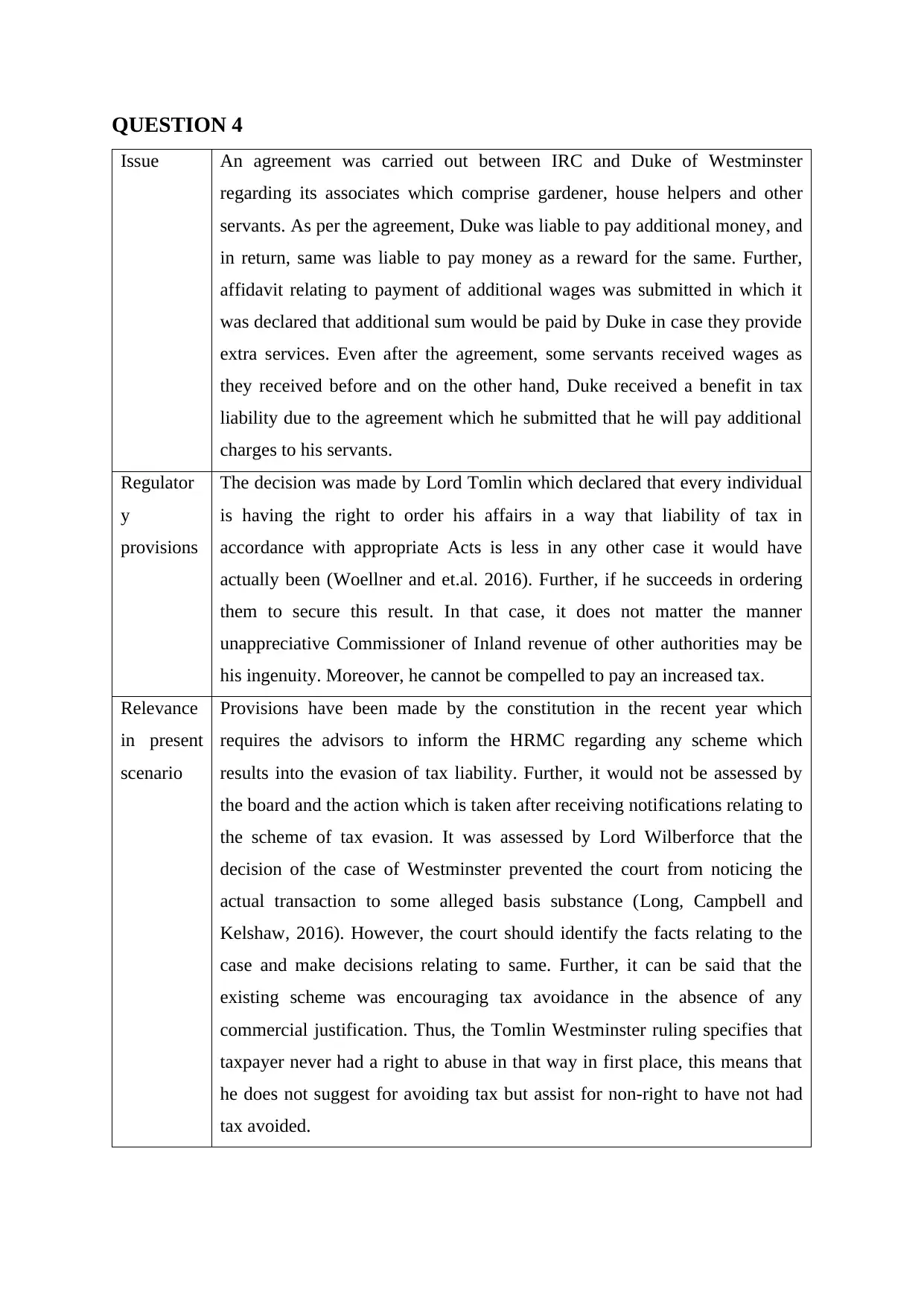
QUESTION 4
Issue An agreement was carried out between IRC and Duke of Westminster
regarding its associates which comprise gardener, house helpers and other
servants. As per the agreement, Duke was liable to pay additional money, and
in return, same was liable to pay money as a reward for the same. Further,
affidavit relating to payment of additional wages was submitted in which it
was declared that additional sum would be paid by Duke in case they provide
extra services. Even after the agreement, some servants received wages as
they received before and on the other hand, Duke received a benefit in tax
liability due to the agreement which he submitted that he will pay additional
charges to his servants.
Regulator
y
provisions
The decision was made by Lord Tomlin which declared that every individual
is having the right to order his affairs in a way that liability of tax in
accordance with appropriate Acts is less in any other case it would have
actually been (Woellner and et.al. 2016). Further, if he succeeds in ordering
them to secure this result. In that case, it does not matter the manner
unappreciative Commissioner of Inland revenue of other authorities may be
his ingenuity. Moreover, he cannot be compelled to pay an increased tax.
Relevance
in present
scenario
Provisions have been made by the constitution in the recent year which
requires the advisors to inform the HRMC regarding any scheme which
results into the evasion of tax liability. Further, it would not be assessed by
the board and the action which is taken after receiving notifications relating to
the scheme of tax evasion. It was assessed by Lord Wilberforce that the
decision of the case of Westminster prevented the court from noticing the
actual transaction to some alleged basis substance (Long, Campbell and
Kelshaw, 2016). However, the court should identify the facts relating to the
case and make decisions relating to same. Further, it can be said that the
existing scheme was encouraging tax avoidance in the absence of any
commercial justification. Thus, the Tomlin Westminster ruling specifies that
taxpayer never had a right to abuse in that way in first place, this means that
he does not suggest for avoiding tax but assist for non-right to have not had
tax avoided.
Issue An agreement was carried out between IRC and Duke of Westminster
regarding its associates which comprise gardener, house helpers and other
servants. As per the agreement, Duke was liable to pay additional money, and
in return, same was liable to pay money as a reward for the same. Further,
affidavit relating to payment of additional wages was submitted in which it
was declared that additional sum would be paid by Duke in case they provide
extra services. Even after the agreement, some servants received wages as
they received before and on the other hand, Duke received a benefit in tax
liability due to the agreement which he submitted that he will pay additional
charges to his servants.
Regulator
y
provisions
The decision was made by Lord Tomlin which declared that every individual
is having the right to order his affairs in a way that liability of tax in
accordance with appropriate Acts is less in any other case it would have
actually been (Woellner and et.al. 2016). Further, if he succeeds in ordering
them to secure this result. In that case, it does not matter the manner
unappreciative Commissioner of Inland revenue of other authorities may be
his ingenuity. Moreover, he cannot be compelled to pay an increased tax.
Relevance
in present
scenario
Provisions have been made by the constitution in the recent year which
requires the advisors to inform the HRMC regarding any scheme which
results into the evasion of tax liability. Further, it would not be assessed by
the board and the action which is taken after receiving notifications relating to
the scheme of tax evasion. It was assessed by Lord Wilberforce that the
decision of the case of Westminster prevented the court from noticing the
actual transaction to some alleged basis substance (Long, Campbell and
Kelshaw, 2016). However, the court should identify the facts relating to the
case and make decisions relating to same. Further, it can be said that the
existing scheme was encouraging tax avoidance in the absence of any
commercial justification. Thus, the Tomlin Westminster ruling specifies that
taxpayer never had a right to abuse in that way in first place, this means that
he does not suggest for avoiding tax but assist for non-right to have not had
tax avoided.
Paraphrase This Document
Need a fresh take? Get an instant paraphrase of this document with our AI Paraphraser
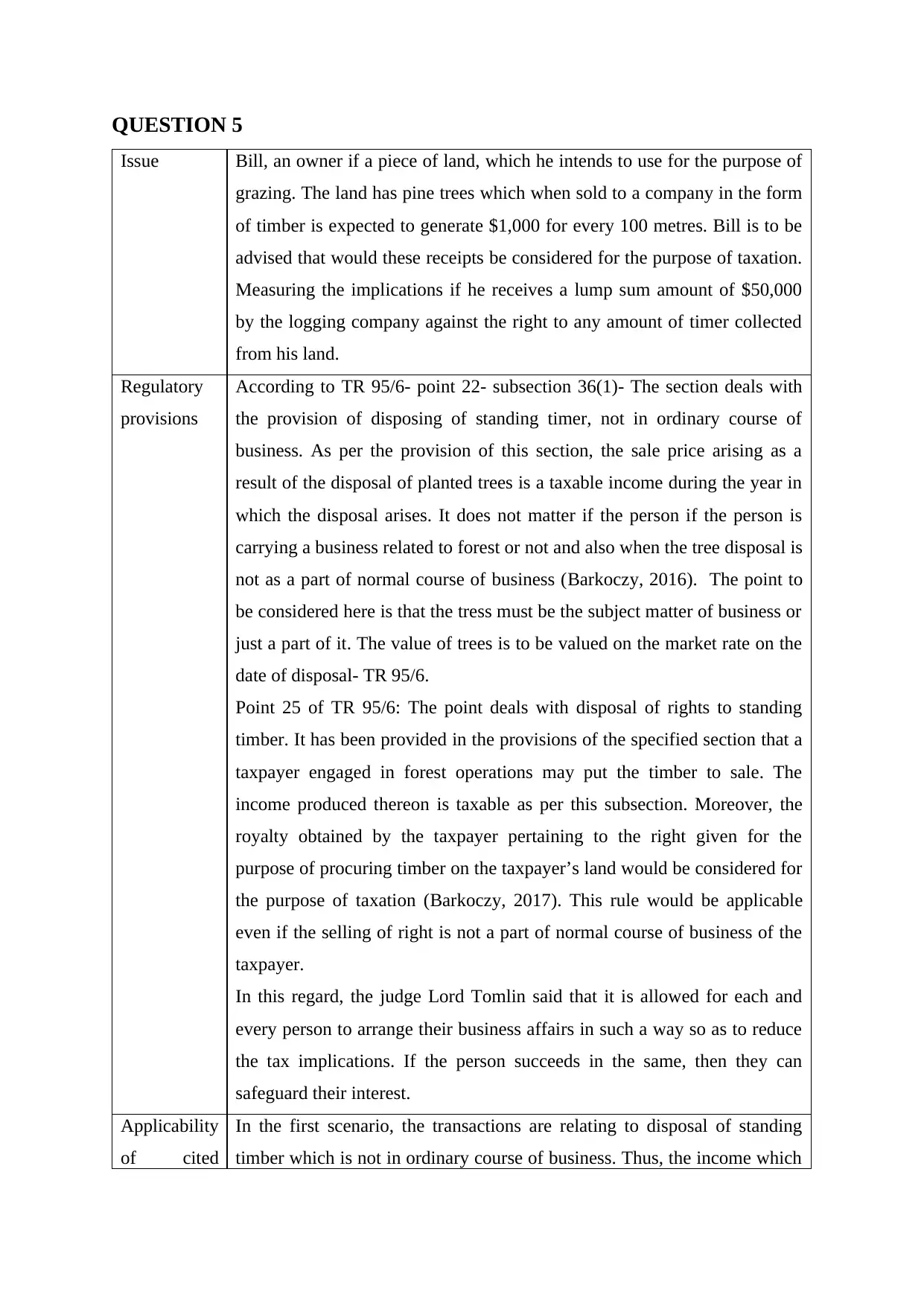
QUESTION 5
Issue Bill, an owner if a piece of land, which he intends to use for the purpose of
grazing. The land has pine trees which when sold to a company in the form
of timber is expected to generate $1,000 for every 100 metres. Bill is to be
advised that would these receipts be considered for the purpose of taxation.
Measuring the implications if he receives a lump sum amount of $50,000
by the logging company against the right to any amount of timer collected
from his land.
Regulatory
provisions
According to TR 95/6- point 22- subsection 36(1)- The section deals with
the provision of disposing of standing timer, not in ordinary course of
business. As per the provision of this section, the sale price arising as a
result of the disposal of planted trees is a taxable income during the year in
which the disposal arises. It does not matter if the person if the person is
carrying a business related to forest or not and also when the tree disposal is
not as a part of normal course of business (Barkoczy, 2016). The point to
be considered here is that the tress must be the subject matter of business or
just a part of it. The value of trees is to be valued on the market rate on the
date of disposal- TR 95/6.
Point 25 of TR 95/6: The point deals with disposal of rights to standing
timber. It has been provided in the provisions of the specified section that a
taxpayer engaged in forest operations may put the timber to sale. The
income produced thereon is taxable as per this subsection. Moreover, the
royalty obtained by the taxpayer pertaining to the right given for the
purpose of procuring timber on the taxpayer’s land would be considered for
the purpose of taxation (Barkoczy, 2017). This rule would be applicable
even if the selling of right is not a part of normal course of business of the
taxpayer.
In this regard, the judge Lord Tomlin said that it is allowed for each and
every person to arrange their business affairs in such a way so as to reduce
the tax implications. If the person succeeds in the same, then they can
safeguard their interest.
Applicability
of cited
In the first scenario, the transactions are relating to disposal of standing
timber which is not in ordinary course of business. Thus, the income which
Issue Bill, an owner if a piece of land, which he intends to use for the purpose of
grazing. The land has pine trees which when sold to a company in the form
of timber is expected to generate $1,000 for every 100 metres. Bill is to be
advised that would these receipts be considered for the purpose of taxation.
Measuring the implications if he receives a lump sum amount of $50,000
by the logging company against the right to any amount of timer collected
from his land.
Regulatory
provisions
According to TR 95/6- point 22- subsection 36(1)- The section deals with
the provision of disposing of standing timer, not in ordinary course of
business. As per the provision of this section, the sale price arising as a
result of the disposal of planted trees is a taxable income during the year in
which the disposal arises. It does not matter if the person if the person is
carrying a business related to forest or not and also when the tree disposal is
not as a part of normal course of business (Barkoczy, 2016). The point to
be considered here is that the tress must be the subject matter of business or
just a part of it. The value of trees is to be valued on the market rate on the
date of disposal- TR 95/6.
Point 25 of TR 95/6: The point deals with disposal of rights to standing
timber. It has been provided in the provisions of the specified section that a
taxpayer engaged in forest operations may put the timber to sale. The
income produced thereon is taxable as per this subsection. Moreover, the
royalty obtained by the taxpayer pertaining to the right given for the
purpose of procuring timber on the taxpayer’s land would be considered for
the purpose of taxation (Barkoczy, 2017). This rule would be applicable
even if the selling of right is not a part of normal course of business of the
taxpayer.
In this regard, the judge Lord Tomlin said that it is allowed for each and
every person to arrange their business affairs in such a way so as to reduce
the tax implications. If the person succeeds in the same, then they can
safeguard their interest.
Applicability
of cited
In the first scenario, the transactions are relating to disposal of standing
timber which is not in ordinary course of business. Thus, the income which
1 out of 8
Related Documents
Your All-in-One AI-Powered Toolkit for Academic Success.
+13062052269
info@desklib.com
Available 24*7 on WhatsApp / Email
![[object Object]](/_next/static/media/star-bottom.7253800d.svg)
Unlock your academic potential
Copyright © 2020–2025 A2Z Services. All Rights Reserved. Developed and managed by ZUCOL.





